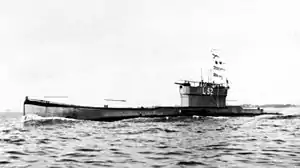HMS L52
HMS L52 was a late-model L-class submarine built for the Royal Navy during the First World War. The boat was not completed before the end of the war and was sold for scrap in 1935.
 | |
| History | |
|---|---|
| Name: | HMS L52 |
| Builder: | Armstrong Whitworth, Newcastle-Upon-Tyne |
| Laid down: | 16 May 1917 |
| Launched: | 18 December 1918 |
| Fate: | Sold for scrap, September 1935 |
| General characteristics | |
| Class and type: | L-class submarine |
| Displacement: |
|
| Length: | 235 ft (71.6 m) |
| Beam: | 23 ft 6 in (7.2 m) |
| Draught: | 13 ft 2 in (4.0 m) |
| Installed power: |
|
| Propulsion: |
|
| Speed: |
|
| Range: | 4,500 nmi (8,300 km; 5,200 mi) at 8 kn (15 km/h; 9.2 mph) on the surface |
| Test depth: | 150 feet (45.7 m) |
| Complement: | 44 |
| Armament: |
|
Design and description
L52 and its successors were modified to maximise the number of 21-inch (53.3 cm) torpedoes carried in the bow. The submarine had a length of 235 feet (71.6 m) overall, a beam of 23 feet 6 inches (7.2 m) and a mean draft of 13 feet 2 inches (4.0 m).[1] They displaced 914 long tons (929 t) on the surface and 1,089 long tons (1,106 t) submerged. The L-class submarines had a crew of 44 officers and ratings.[2] They had a diving depth of 150 feet (45.7 m).[3]
For surface running, the boats were powered by two 12-cylinder Vickers[4] 1,200-brake-horsepower (895 kW) diesel engines, each driving one propeller shaft. When submerged each propeller was driven by a 600-horsepower (447 kW) electric motor. They could reach 17 knots (31 km/h; 20 mph) on the surface and 10.5 knots (19.4 km/h; 12.1 mph) underwater. On the surface, the L class had a range of 4,200 nautical miles (7,800 km; 4,800 mi) at 10 knots (19 km/h; 12 mph).[1]
The boats were armed with six 21-inch torpedo tubes in the bow. They carried eight reload torpedoes for a grand total of a dozen torpedoes.[5] They were also armed with two 4-inch (102 mm) deck guns.[2]
Construction and career
HMS L52 was laid down on 16 May 1917 by Armstrong Whitworth at their Newcastle-Upon-Tyne shipyard, launched on 18 December 1918, and completed on 18 January 1921. The boat was sold for scrap in September 1935, but was wrecked off Barry, South Wales.
Notes
- Gardiner & Gray, p. 94
- Akermann, p. 165
- Harrison, Chapter 11
- Harrison, Chapter 25
- Harrison, Chapter 27
References
- Akermann, Paul (2002). Encyclopaedia of British Submarines 1901–1955 (reprint of the 1989 ed.). Penzance, Cornwall: Periscope Publishing. ISBN 1-904381-05-7.
- Colledge, J. J.; Warlow, Ben (2006) [1969]. Ships of the Royal Navy: The Complete Record of all Fighting Ships of the Royal Navy (Rev. ed.). London: Chatham Publishing. ISBN 978-1-86176-281-8.
- Gardiner, Robert & Gray, Randal, eds. (1985). Conway's All the World's Fighting Ships: 1906–1921. Annapolis, Maryland: Naval Institute Press. ISBN 0-85177-245-5.
- Harrison, A. N. (January 1979). "The Development of HM Submarines From Holland No. 1 (1901) to Porpoise (1930) (BR3043)". Submariners Association: Barrow in Furness Branch. Archived from the original on 19 May 2015. Retrieved 19 August 2015.
